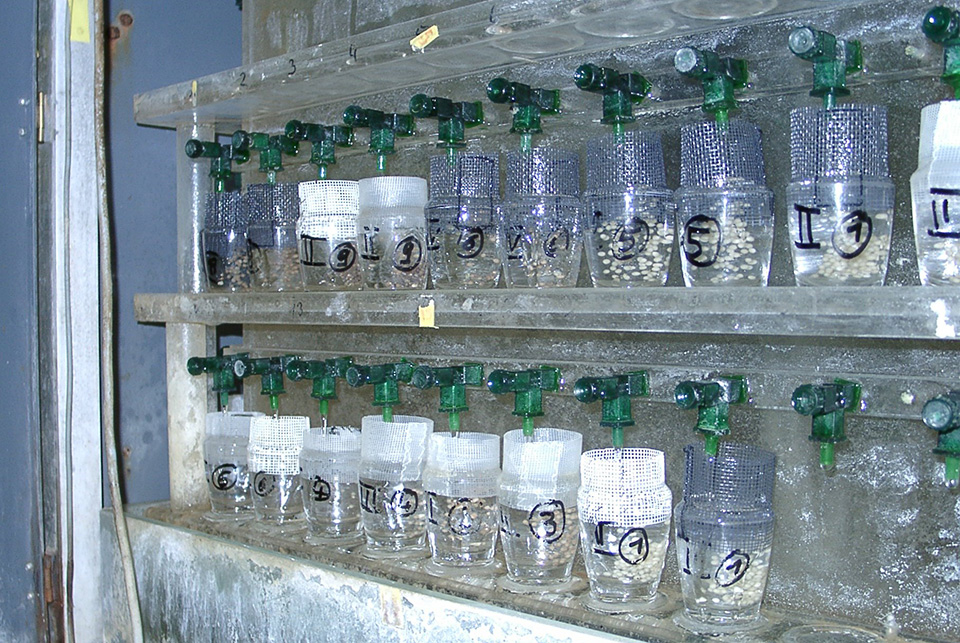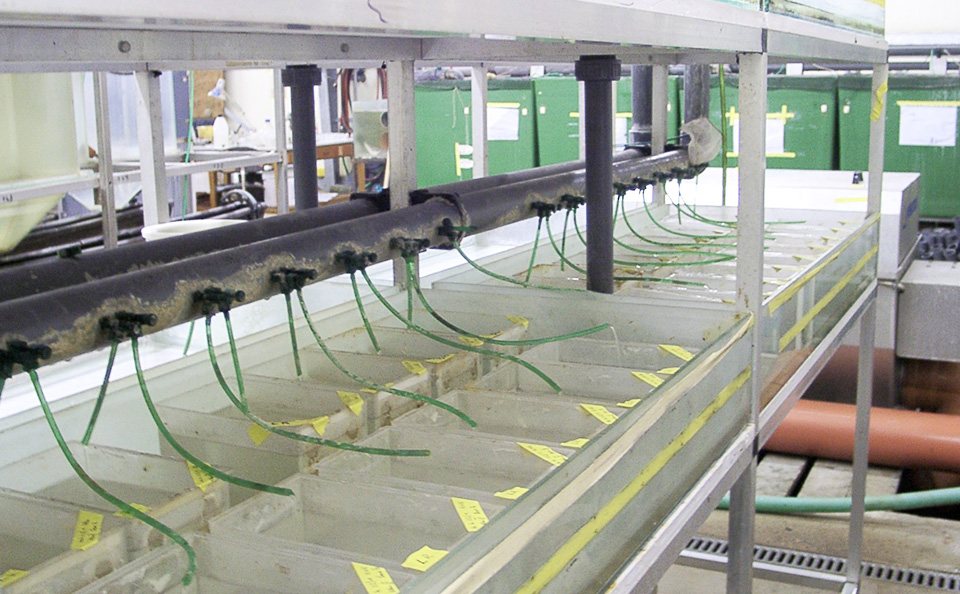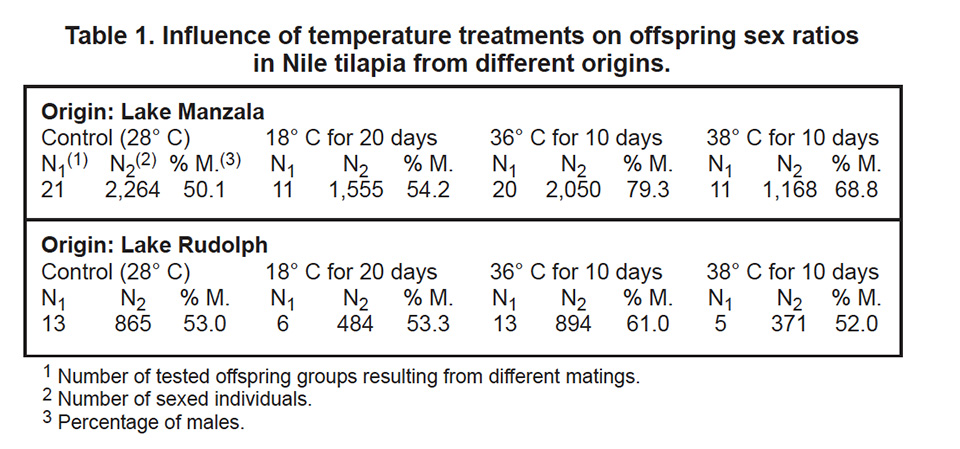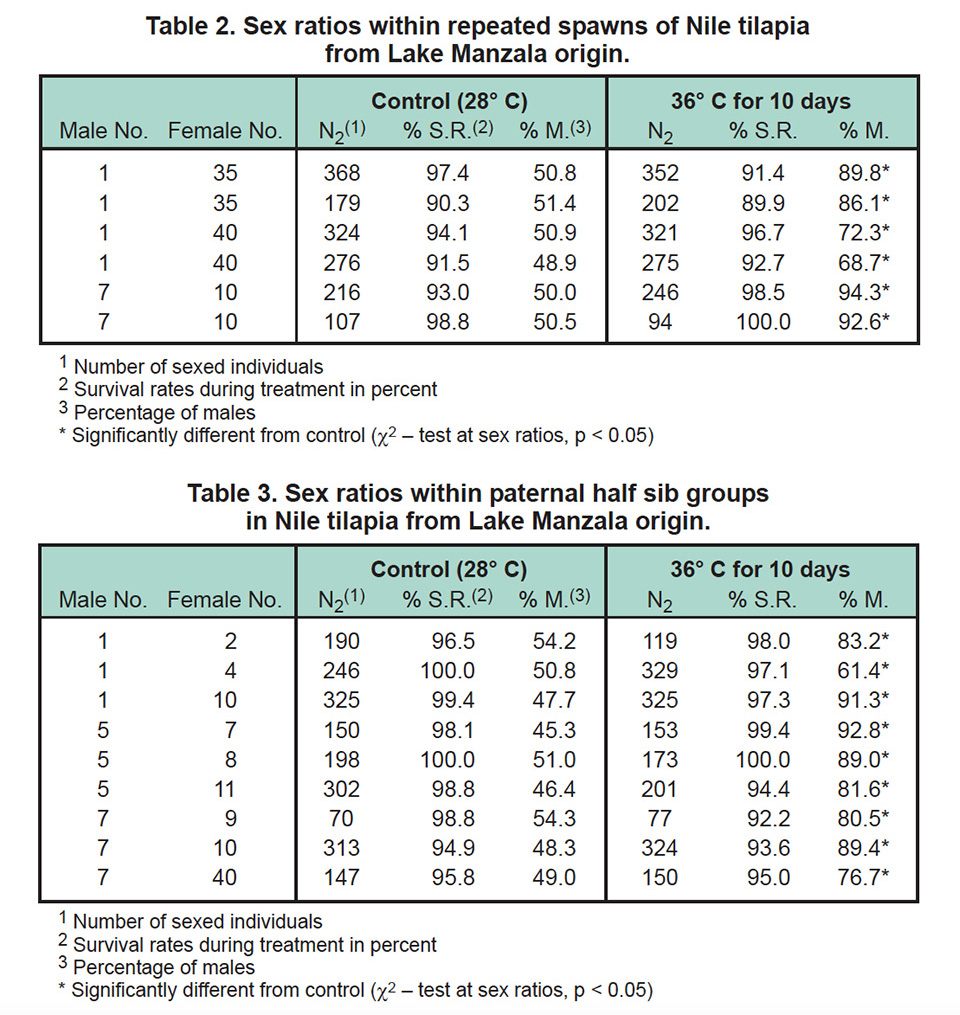Interactions between genotype, temperature

The importance of monosex (male) culture for profitable Nile tilapia aquaculture has long been recognized. Masculinizing with hormones is in many cases done to increase the percentage of males. A growing number of consumers is interested in environmentally-friendly production and do not accept products that were produced with the use of hormones or similarly active substances. Environmental factors can influence the sex determination of reptiles and fishes, and this knowledge could be useful to develop all-male Nile tilapia stocks without the use of hormones in the near future.

Temperature and sex ratios
Initial indications on the influence of temperature on sex ratios in lizards go back to the mid-1960s. Numerous studies conducted since then have shown temperature-dependent sex determination in other reptiles like turtles and alligators, and later also in some fish species.
Different species models have been reported, where sex ratios are skewed to one sex at high or low temperatures, or where one sex results from intermediate and the other sex from lower and higher temperatures during egg incubation or fry rearing (Lemma, 2001).
Study setup
We recently conducted a study to test the effect of different fry rearing temperatures on the sex ratios of Nile tilapia (Oreochromis niloticus) from two different sources: Lake Manzala in Egypt and Lake Rudolph in Kenya. Male and female breeders from both sources were individually tagged and maintained in glass aquaria. Fish were manually stripped when the females showed signs of readiness for spawning (swollen and redden urogenital papilla and territorial behavior). After artificial fertilization, eggs and hatching larvae where incubated at 28 degrees-C up to day 9 after fertilization.
Temperature treatments
At day 9 the individual offspring groups were separated into treatment and control groups. Controls were maintained at a constant 28 degrees-C. Temperature treatments where applied at 18 degrees-C for 20 days or at 36 degrees-C and 38 degrees-C for 10 days starting on day 10, and then survival rates in the treatment and corresponding control groups were recorded. Then all groups were separately reared at 28 degrees-C until individual fishes could be sexed by external examination. Differences in sex ratios between treatment and control groups where analyzed for significance by χ2 -tests (p < 0.05).
Results
Table 1 shows data on the sex ratios observed within full sib groups of randomly selected male and female breeders from the two original sources, after different temperature treatments and in the corresponding control groups. Treatments with 18 degrees-C for 20 days typically did not result in sex ratios significantly different to controls. In contrast, in most cases the 36 degrees-C treatment for 10 days led to a significantly higher percentage of males when compared with the corresponding controls.

Increasing the treatment temperature to 38 degrees-C did not increase male percentages, when compared to the 36 degrees-C treatment. Because survival rates in controls and treatment groups were similar (controls at 28 degrees-C, 95 percent survival; at 18 degrees-C treatments: 91 percent survival; at 36 degrees-C treatments: 95 percent survival; at 38 degrees-C: 87 percent survival), differences in survival rates between sexes are probably not responsible for the observed differences between treatment and control groups.
Considerable differences in the sensibility of the sex determining mechanism to temperature treatments were observed between animals of different origin (Table 1). In the 36 degrees-C treatment, 17 of the 20 tested offspring groups with a Lake Manzala origin showed significantly more males than the corresponding control groups. The mean percentage of males after 36 degrees-C treatment was 79.3 percent (range 44 to 100 percent). For animals of Lake Rudolph origin, only three of the 13 tested groups showed a significantly increased percentage of males. The mean value of 61.0 percent (range 44 to 79 percent) was also lower.
Repeatability and individual influence
To examine the repeatability of the response of sex ratios to temperature treatment, spawns were repeated (Table 2). The percentages of males in the 36 degrees-C treated replicated spawns differed only by 1.7 to 3.7 percent.

Observations within groups of paternal half sibs showed the individual influence of breeders on the response of the sex ratio to the temperature treatment. Table 3 shows data from three different males each mated with three randomly selected females. Compared to their control groups, all groups treated at 36 degrees-C showed significantly higher percentages of male offspring, and the level of response to the treatment depended on the individual females. Differences in sex ratios of up to approximately 20 percent were observed within half sibs of single males.
Conclusion
Results of this study showed that simple temperature treatments can repeatedly increase the percentage of males in the offspring of Nile tilapia of different origins. The resulting sex ratios in offspring of populations of different origin and individual fish from the same origin after temperature treatments evidence the interactions between genotype and the sensitivity of the sex determination in Nile tilapia to temperature treatment.
The genetic component of the observed response of sex ratios to temperature treatments is promising for genetic improvement. Further experiments will evaluate selection programs to generate Nile tilapia strains that can efficiently and cost-effectively produce all-male stocks by temperature treatments.)
(Editor’s Note: This article was originally published in the February 2003 print edition of the Global Aquaculture Advocate.)
Now that you've finished reading the article ...
… we hope you’ll consider supporting our mission to document the evolution of the global aquaculture industry and share our vast network of contributors’ expansive knowledge every week.
By becoming a Global Seafood Alliance member, you’re ensuring that all of the pre-competitive work we do through member benefits, resources and events can continue. Individual membership costs just $50 a year. GSA individual and corporate members receive complimentary access to a series of GOAL virtual events beginning in April. Join now.
Not a GSA member? Join us.
Authors
-
Misikire Tessema Lemma, Ph.D.
Institute of Animal Husbandry and Genetics
University of Göttingen
Albrecht-Thaer-Weg 3
D-37075 Göttingen, Germany -
Andreas Müller-Belecke, Ph.D.
Institute of Animal Husbandry and Genetics
University of Göttingen
Albrecht-Thaer-Weg 3
D-37075 Göttingen, Germany[101,100,46,103,100,119,103,64,53,101,108,108,101,117,109,97]
-
Gabriele Hörstgen-Schwark, Ph.D.
Institute of Animal Husbandry and Genetics
University of Göttingen
Albrecht-Thaer-Weg 3
D-37075 Göttingen, Germany
Related Posts

Responsibility
‘Model’ tilapia venture shows mettle in Mozambique
On the shores of Lake Cahora Bassa, Chicoa Fish Farm hopes to create a ripple effect to improve fish supply and quality of life for an impoverished region.

Health & Welfare
GESIT tilapia: Indonesia’s genetic supermales
Tilapia quickly reach sexual maturity in culture, and unless controlled, the fish reproduce and offspring compete for food. All-male culture of tilapia is preferred because of their fast growth and larger average size.

Health & Welfare
Tilapia show immunization response against Ich
In research on alternatives to formalin treatment to control Ich infestation, the authors performed a study that compared the immune responses of Nile tilapia and red tilapia against the parasite.

Health & Welfare
Sizing up TiLV and its potential impact on tilapia production
An international research effort has commenced to find a solution for Tilapia Lake Virus (TiLV), a contagion causing high rates of mortality in farmed and wild tilapia stocks in Israel, Colombia, Ecuador, Egypt and Thailand.


